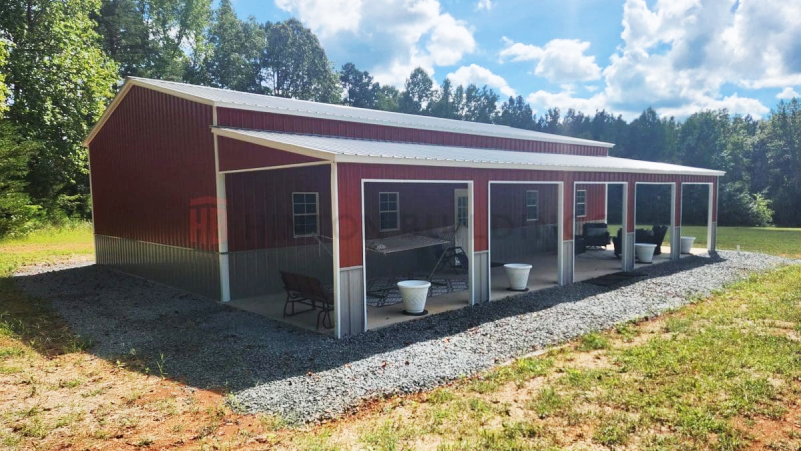
Upgrading your carport to include a garage door is a fantastic way to add value and security to your home while offering more functionality and style. This type of enhancement provides numerous advantages, ranging from protection against the elements to increased property value.
Such a transformation can be especially appealing if you’re looking to shield your car from harsh weather or simply want extra security for your belongings. From initial planning stages to selecting materials and options, exploring our tips on how to upgrade a carport with a garage door will make your work go smoother, ensuring you get the result you want.
When undertaking a carport-to-garage conversion, there are a few key details to think about to ensure you maximize available space.
One of the first considerations should be space planning. Begin by measuring your current carport to understand how it will accommodate a garage door. Consider the height, width, and depth of the area to ensure it can accommodate vehicles and storage needs.
Next, think about how you will use the additional enclosed space. Will it strictly house your car, or do you plan to add workbenches and storage units? Planning how you’ll utilize the space will guide the rest of your decisions, from garage door size to interior layout.
Lastly, consider future expansion. If you foresee adding additional vehicles or equipment, plan for a garage door and structure that can easily adapt to these changes. This foresight can save you money and hassle down the road.
Selecting the appropriate materials for your garage door is crucial to ensure longevity and suitability for your specific needs. Various materials offer different benefits, and it’s essential to consider factors such as climate, budget, and aesthetics.
Steel is a popular choice due to its durability and low maintenance requirements. It’s strong, resistant to denting, and can be styled to mimic other materials, such as wood, making it a versatile option. If you live in an area with extreme weather, consider opting for insulated steel doors to improve energy efficiency.
Wooden garage doors bring a classic and natural look to your home. They offer excellent flexibility in terms of style, as they can be customized with a variety of stains and designs. However, they do require more maintenance than other materials, as they need to be treated for protection against the elements.
Aluminum doors are lightweight, corrosion-resistant, and suitable for wider applications where heavier materials might require additional structural support. They are more affordable than steel or wood, but they can be prone to denting and may not provide the same level of insulation.
Fiberglass garage doors are a solid choice for those seeking a material that resists denting and can withstand harsh weather conditions. They are lightweight and can be made to resemble wood, but they may turn yellow over time and can become brittle in extremely cold temperatures.
Vinyl garage doors are known for their durability and resistance to dents. They require little maintenance and can withstand harsh weather, making them an excellent option for coastal or humid environments. Although their color options might be limited, they promise long-lasting performance with minimal upkeep.
Garage doors come in various configurations, including roll-up, sectional, and tilt-up. Each type has its pros and cons:
By exploring available doors and considering how they operate, you can choose one that fits your needs and budget.

A garage door is only as functional as its opener. Choosing the right opener involves considering factors such as drive type, horsepower, and noise level:
In addition, some models come with a built-in Wi-Fi feature that allows remote access and monitoring, adding convenience and security to your setup.
Enhancing your garage’s security is an essential step in the upgrade process. Modern garage door systems offer a variety of features designed to safeguard your home and belongings.
Motion-detection lighting is a simple yet effective security measure that can deter potential intruders. Consider installing lights around the garage perimeter that activate when movement is detected.
Additionally, ensure your garage door opener includes rolling code technology, which generates a new, unique access code each time the remote is used. This feature prevents would-be thieves from capturing your code and gaining entry.
Lastly, invest in a robust lock mechanism for times when you’ll be away for extended periods. Look for smart locks that allow for remote management and alerts when unauthorized attempts occur.
Before beginning construction, it’s critical to ensure compliance with local building codes and regulations. Contact your local government office to determine if you need specific permits for your carport conversion.
The permitting stage may take some time, so plan accordingly to avoid delays in your project timeline. Having the right paperwork in place beforehand will provide peace of mind and prevent potential legal issues.

Deciding whether to tackle the garage conversion yourself or hire professionals is a significant consideration. Both options have their advantages and potential pitfalls.
For the handy homeowner, DIY can offer significant cost savings and a sense of accomplishment. However, it’s important to assess your skill level and the complexity of the tasks involved. Mistakes can lead to increased costs and even safety issues.
On the other hand, hiring a professional ensures the job is done correctly and efficiently. Professionals bring expertise, tools, and experience to the table, reducing the likelihood of costly errors.
Weighing these factors will help you make an informed decision that aligns with your skills and budget.
Upgrading a carport with a garage door is a rewarding project that enhances both the functionality and value of your space. By carefully considering each aspect of the transformation, you can achieve the results you’ve been waiting for.
Are you tired of dealing with structures that don’t meet your expectations? At Hinton Buildings, we’re your metal building builders. With us as your partners, your carport conversion can become a standout feature of your home for years to come.
